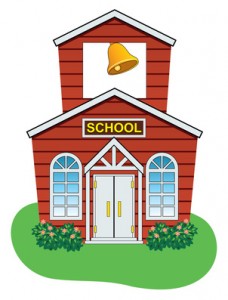 The neighborhoods you consider while house hunting may be determined, in part, by school districts and educational choices. If you’ll be sending your children to public school, ratings and other assessment tools can help you judge the merit of the schools near you. If you’re considering a private school, you may have to sort through programs with a wide range of philosophical backgrounds. Read on to learn about school ratings, types of schools and other factors to consider.
The neighborhoods you consider while house hunting may be determined, in part, by school districts and educational choices. If you’ll be sending your children to public school, ratings and other assessment tools can help you judge the merit of the schools near you. If you’re considering a private school, you may have to sort through programs with a wide range of philosophical backgrounds. Read on to learn about school ratings, types of schools and other factors to consider.
Finding Information About School Districts
School ratings and test score data can be found through your State Department of Education website. According to Project Appleseed, the National Campaign for Public School Improvement, “The [federal] No Child Left Behind legislation requires an annual school report card for all schools. School report cards describe characteristics of the school, including the number of children, various test scores, ratios of teachers to students, ethnic ratios, poverty levels, and more. Report cards can usually be obtained by contacting the department of education in the state or the school district office where the school is located.”
If you’re considering several regions at once, you can get State Education Data Profiles by accessing the National Center for Education Statistics website. To compare school districts in another way, visit GreatSchools.org to conduct a school search. GreatSchools, which is based in San Francisco, offers free information for parents all over the nation.
What to Consider when Choosing a School
When you look for information about a school district, you have a lot to consider. Not only should you look at test scores and class sizes, but you should also consider the particular needs of your child. Project Appleseed suggests that you should assess schools with these things in mind:
- Your child’s personality and learning style
- Your family’s values, budget, and needs
- School philosophy and style of instruction
- School facilities and personnel
- School policies and schedules
- The school’s reputation in the community
- Core curriculum and additional courses
- The school’s approach to safety
- Family and community involvement
If your dream house turns up in a school district with poor school ratings, don’t give up hope. It may be possible to get a geographic exception to send your child to a different school. While this may rule out traveling by school bus, it could be a good compromise if you need to be close to work or have other reasons for choosing a home in a less-than-ideal school district.
Transportation
How far will your child have to walk to reach school bus stops? This can be a serious concern in areas with cold winters or in rural areas, where bus stops may be far apart. According to the American School Bus Council, school buses are safer than cars and provide vital transportation to 26 million students every day. With 480,000 buses operating in the U.S. at any given time, there’s a good chance your student will be riding one to school.
When assessing transportation options for your child, ask these questions:
- Where is the nearest school bus stop?
- How long will my child’s commute last each day?
- When will my child be picked up and dropped off? (You’ll want to escort younger children to and from the stop for safety.)
- Will bus routes change in inclement weather?
School Violence and Bullying
It’s unfortunate, but parents need to consider more than academic ratings before putting an offer on a house. School violence can be difficult to judge. Online school rating websites can be helpful, as can phoning and asking for information on school violence from local school districts. Don’t be afraid to ask tough questions; where your child goes to school can have a long-lasting effect on his life.
The National School Safety Center strives to advocate for “safe, secure, and peaceful schools worldwide as a catalyst for the prevention of school crime and violence.” Their website offers school safety statistics and resources.
It’s Only Your Child’s Future!
Not to scare you, but the choices you make today will shape your child’s future. All children deserve to learn in a safe, comfortable environment. You know your child best, and as you look for a house in a good school district, you’ll need to keep his or her particular needs in mind. If you know your child will thrive in a big, bustling classroom or a quiet space for a small group, for instance, you can use that knowledge to go beyond the statistics. Talk to staff, see if you can tour some classrooms, and take the time to find a great school before you buy a home.
If you need help finding a school district or school near you, you can visit the U.S. Department of Education’s website to search their comprehensive database. You can use their search tools to find public schools, private schools, and school districts all over the country. Their database includes facts like enrollment numbers, student demographics, teacher/student ratios, and school contact information.
